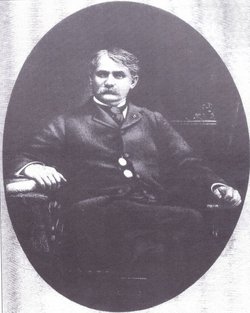Black Rebellion, Militarized Police Violence, and White Vigilantes
Wednesday, August 11th, 2021America on Fire; The Untold History of Police Violence and Black Rebellion Since the 1960’s, Elizabeth Hinton, 2021
<> <> <> <> <> <> 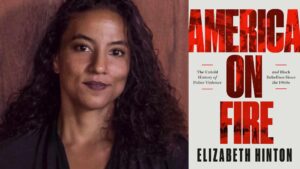
There have been histories covering black rebellions since 1619 such as Missed Opportunities and Four hundred souls : a community history of African America, 1619-2019, as well as the New York Times published 1619 Project. This book is an American history from the Civil Rights Act of 1964 to the present. Hinton insists that the violent events covered here be called Rebellions and not riots or demonstrations or mob behavior.
<> <> <> <> <> <> 
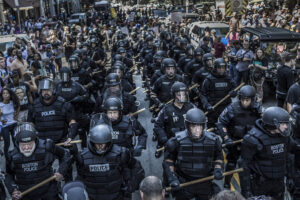
<> <> <> <> <> <> Do these look like “Peace Keepers”?
The militarization of the police:
(Police) Officers threw grenades filled with either chloroacetophenone (CN), the tear gas most commonly used to quell rebellion or 0-chlorobenzylidene malononitrile (CS) or “super” tear gas… The chemical weapon (CS) proved effective in pursuing the Vietcong through underground bunkers and tunnels, and in putting down rebellions in black neighborhoods. The use of tear gas in US overseas interventions correlated directly with its use at home. by 1969, the Department of Justice had facilitated the low-cost sale of more than 70,000 gas masks to local law enforcement, along with other surplus military equipment including body armor, armored vehicles and (assault) rifles.
During the 1990s, the Taser was introduced to law enforcement use as an alternative to deadly force. As of 2011, more than 15,000 law enforcement agencies in the United States used the Taser. Police now routinely use rubber bullets and pepper spray adding to their “non-lethal” arsenals.
The rise of new white vigilante groups:
Ignoring the Mayor (Stenzel of Cairo Illinois), they formed the Committee of Ten Million The job of the vigilante group would be to carry out the heavy-handed response the Mayor seemed unwilling to delivery. Similar groups had been coming together since the civil rights movement first gained momentum in the 1950s. Unlike many of the lynch mobs that had terrorized Black communities from Reconstruction to the middle of the next century. these new white supremacist groups attracted a more genteel class. The founders of the Committee of Ten Million included Peyton Berbling, the wealthy, chain smoking, white haired lawyer in his early seventies who had served as district attorney and would return to the post in 1968. Larry Potts, the dapper pastor of Cairo Baptist Church; the prominent local businessman Tom Madra; the lumber dealer Bob Cunningham. Like the Citizen’s Councils of America that could be found across the South, the Committee of Ten Million used intimidation and violence to counter the freedom movement, relying not only on brute force but also their political and economic power.
In 1969 another white vigilante force emerged in York Pennsylvania.
In York and Cairo, Black people lived in the areas most susceptible to flooding, and those that didn’t make it into public housing lived in deteriorating tenements by white slum landlords. the mayors were unresponsive to ongoing demonstrations for jobs and better living conditions, and reluctant to solicit federal War on Poverty funds that might have helped to address these problems.
<> <> <> <> <> <> 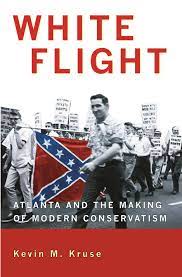
White Flight
York and Cairo were distinguished by the close alliance between law enforcement and white power vigilante groups. York uprisings in the late 1960s were the most severe of the era. The Cairo rebellion lasted longer than any of the era. The white men in power both politically and economically saw no reason to change the institutions that systematically locked Black people out of jobs, decent housing, and educational opportunities. The extreme reactions of the white power groups effectively killed the town of Cairo, once a Mississippi river boat stop, today only 2,000 residents remain, 2/3 of them Black. In 1950 the population of Cairo was over 12,000. White flight was occurring all over America, particularly in smaller communities. The result of these policies was often white flight to the suburbs. Cairo was effectively dead and Harrisburg lost 22% of its population.
By 1970 the (Cairo United) Front had created a food distribution network with the Urban League and other sympathetic supporters in Chicago, who would send tons of canned goods, household items, clothing, and toys…The United Front offered Cairo residents free legal aid services and (limited) medical care. It established a day care center, a pig farm, a factory that made prefabricated housing, a women’s clothing store, and a grocery store all based on the principles of collective ownership…At the center of the United Front’s activities during the ongoing conflict in Cairo was its boycott of white merchants.
Reverend J.J.Cobb of Cairo: “The way we see it from where we stand, is that every time we strive to do something to help ourselves there are more policemen armed with guns, more ammunition is bought to put a stop to the drive to better the conditions of the Negro.”
Charles A. O’Brien, deputy attorney general of California issued a rare statement during a hearing in 1970:
A major key to conquering this problem is to stop making the policeman the scapegoat for all of societies ills. We cannot continue to solve all our problems by passing new criminal laws. The policeman today bears the brunt of the failures of government. Poverty, inequality, disease, ignorance, and the alienation of youth were not caused by the policeman, but he is the agent who most often comes face to face with these problems. He is the one who has to put the lid back on. We must demand that the other segments of government do more–social agencies, educational institutions, college administrators, public law offices. All of these other agencies on which we spend billions must be asked to do more, to bear more of the burden, to act more creatively, to assume more responsibly.

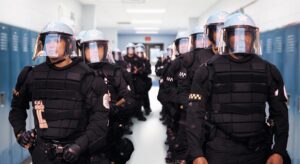
Policing schools and the school-to-prison pipeline.
One of the most profound and negative effects of this focus on law enforcement was sending police into the public schools instead of addressing the lack of Black and other minority teachers, the white biased curriculum, outright discrimination against Black students like preventing Black students from taking elected office or joining cheer leading teams.
Yet, in Harrisburg (Pennsylvania), Cairo, and across the country, officials at all levels ultimately pursued the punitive path. After the violence of the late 1960s and early 1970s, policymakers attempted to relieve police-community tensions by pacifying the over-policed and unruly community. The strategy of managing the problems caused by systemic racism with crime control measures left Harrisburg economically stagnant, segregated, and with a failing school system.
Local, state, and federal agencies had “joined a vicious circle of racial discrimination and economic depression.”
Miami 1980 The most violent Rebellion.
In 1980, the white Kulp brothers, newly arrived in Miami from Pennsylvania, with a girlfriend drove into the heart of Liberty City where both boys were killed after a brick shattered their windshield and their car crashed hitting a 75 year old man and pinning a young Black girl into a wall. Both brothers were killed by a mob of Black witnesses, but a Black taxi driver drove the white girlfriend out of Liberty City. Thus started the 1980 Miami rebellion, seemingly coming out of nowhere and yet the most violent seen since 1964.
…by the mid 1970s this (Blacks locked out of political power) had changed, with levels of Black political leadership resembling those of the Reconstruction era “seven magic years”…The formation of the Congressional Black Caucus in 1971…Black elected officials began campaigns to bring job training programs, welfare provisions, health care, and social services to their constituents. It seemed that the Black freedom struggle had shifted from direct action to formal politics…But (in Miami) Black owned business spiraled into a sharp decline…Black residents owned 25 percent of all gas stations in Dade county in 1960. By 1979 that figure had dwindled to 9 percent, while Cuban and South and Central American-owned stations quadrupled from 12 to 48 percent. Between 1968 and 1979, Latinx applicants received $47.3 million (in SBA grants), or about 47 percent of the total SBA grants in Miami, while Black applicants were awarded a paltry $6.5 million.
The average income of Latinx owned businesses in places like Little Havana were double those of Black owned businesses. Then, in 1980, the Mariel BoatLift brought another 125,000 Cubans to the Miami area. Black jobs became even more scarce with this new influx of favored laborers. Between 1977 and 1981 another 70,000 Haitians arrived in Miami, after fleeing the dictatorship of Jean Claude Duvalier. They were treated even worse than existing Blacks already living in Miami. 90 percent of Federal relief sent to Miami after 1980 Black rebellion went to white, Cuban, and other Latin owners who opened businesses in non Black communities. President Carter sent $6 million to Miami for a job training program. Black participants never found work. The devastation to Liberty City and Overtown were so extensive that residents had to travel up to 30 miles to shop. Two years after the Rebellion 70 percent of residents were out of work. The acquittal by an all white jury of Officer Alvarez for killing a Black man in 1984 set off another conflagration in Liberty City, Overtown, and Coconut Grove. In 1989 a Colombian born officer Lozano killed a Black motorcyclist who then crashed killing his Black passenger setting off a four day rebellion in Overtown. Officer Lozano was convicted of manslaughter in 1990 but his conviction was overturned in 1991 because the original jurors were ruled to have voted for conviction because of the fear of setting off riots.
LA, Rodney King Rebellion, and the Gangs
The Rodney King beating in 1991 by four white police officers which was captured on video set off a five day rebellion killing more than 50 people and causing more than $1 Billion in property damage.
<> <> <> <> <> <> 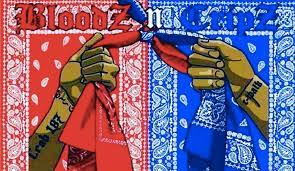
in 1992 warring Crip and Blood gangs understood the rebellion not as a moment of wanton destruction, but as an opportunity to transform themselves and their community. By moving to end the violence, the gangs hoped to win political influence and to control scarce resources on their own terms.

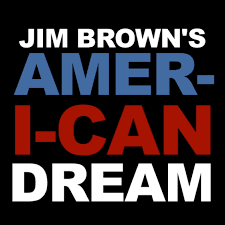

Much of the impetus for this effort originated in the Amer-I-Can program, run by former NFL star Jim Brown. Most of the young men who would organized the truce in 1992 were trained in the program. With the Black Panthers and other radical organizations were no longer viewed as a major threat by the early 1970s, law enforcement turned its attention to street gangs, many of which had been operating for decades. In 1992, the reported number of gang related homicides in Los Angeles County peaked at 803, a 77 percent increase in four years. Two decades of police gang control measures had failed. The Reagan “War on Drugs” in 1984 lead to mass incarceration on a scale seen nowhere else in the world.
Yet as the 1992 rebellion raged and the city burned, members of the Crips and the Bloods in Watts set out to bring internal warfare to an end, and to face common external enemy–systemic racism, embodied most immediately by the police–as a united front.
On April 26 and 28 1992, gang treaties were agreed to and the next day the four officers who beat Rodney King on video walked free. What really got the gangs attention was the killing of a Black ninth grader by a Korean store owner over a $1.79 orange juice. Federal, state and local law enforcement saw the 1992 rebellion as an opportunity to target “gangs” and “illegal immigrants”, exactly the opposite of the Crips and Bloods vision of ending the violence.
When the rebellion started…,graffiti in Watts already announced the (Crips and Bloods) truce agreed to the day before. The uprising had the effect of cementing it. Unity parties in Imperial Courts and Nickerson Gardens went on as the surrounding areas burned. On May 3, the day before the rebellion ended, the Pirus Bloods in the Hacienda Village housing project entered the accord, meaning that there would be peace throughout Watts going forward.
Property damage was light and the police alone were responsible for the three deaths in Watts. The gangs proposed that unarmed gang members would be trained to accompany any police officer on duty in Watts in a program that would institutionalize the Black Panthers’ Community Alert Program of the 1960s. The treaty was still in effect in 1997 four years later.
Gang probation officer Jim Galipeau: “The only tragedy of the truce was that society needed to reward the gang members who created it, yet didn’t do a damn thing.”
The Bloods and the Crips had asked for a mere six million dollars to transform policing in South Central. “Give us the hammer and the nails, and we will rebuild the city” their 1992 proposal had begged.
About the only positive outcome, other than a dramatic drop in violence, was the creation of a gang intervention program where gang members were employed by the city to defuse violence.
Cincinnati and the Failed Federal and ACLU efforts to reform the police, and Cincinnati Gentrification
By 2000, white flight reversed into massive gentrification programs, most exemplified by booming white enterprises in Cincinnati. The inequality and social injustice of bad schools and lack of jobs created a tinder box that was lit by a police killing in 2001, resulting in a multi day rebellion. This time, the violence got the attention of Federal policy makers interested in police reform. The ACLU and the Cincinnati Black Front sued the Cincinnati police over the killing that set off the rebellion. A Collaborative Agreement was negotiated in 2002 and it was signed by the city one year after the start of the rebellion. Separately the Department of Justice entered into a Memorandum of Agreement (MOA) with the city and the Cincinnati Police Department. A federal monitor Saul Green, and a small team of Justice Department investigators would remain in Cincinnati for five years to assure that the Agreement was implemented and maintained. When the city failed to comply with the Agreement it was extended for another two years. In 2006 the police department effectively threw the Agreement out the window implementing “Operation Vortex” targeting areas where “gentrification” was planned and Blacks and other poor needed to be removed before “renovations” could start.
<> <> <> <> <> <> 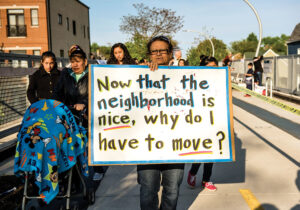
Rebellions, both peaceful and violent happened across America throughout the Obama years.
Both strains of Black protest have served important purposes historically. Any success of the nonviolent, direct political action of the civil rights movement depended on the threat of violent, direct political action. As Martin Luther King Jr. himself recognized, the power of mass nonviolence arose in part from its capacity to suggest the coercive power of violent resistance should demands not be met.
Rebellions of 2020 were all started nonviolently and became violent only after police provocation or violence.
New Coalition based Rebellions start in 2020
Rebellions throughout America, from those in the 1960s to Cincinnati in 2001, mainly involved Black protestors, yet the most sustained collective violence in 2020 did not emanate from Black ghettos. In a reversal that would have been unthinkable not so long ago, it came from majority-white cities and suburban communities. Most of the looting in 2020 took place in upscale neighborhoods, and it targeted high-end retailers like Gucci and Tiffany&Co. on Rodeo Drive in Beverley Hills…Confrontations between protestors and police were most intense and protracted in cities like Portland and Seattle, among the whitest cities in America…An estimated 95 percent of counties where protests took place were majority white, and three-quarters of these counties were 75 percent white.
The 2020 demonstrations revealed that racial justice champions, environmental activists, LGBTQ-rights advocates, and labor unions appear to be stitching together a new coalition…In Cincinnati…,left wing activist groups now called for a redistribution and redirection of resources away from police departments and prison systems and toward programs that would improve mental health services, address climate change, and provide better housing, education, and job opportunities for all Americans…in 2020 some public officials and police officers participated in the demonstrations to express support for the anti-racist cause.


